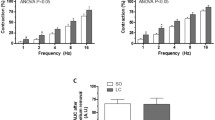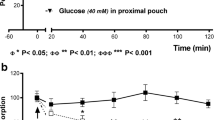Abstract
It has long been recognized that intestinal blood flow increases at mealtimes. Mesenteric hyperaemia is also evoked by activation of sensory peptidergic nerves. Our studies explored the possible role of endogenous nitric oxide (NO) in the rat intestinal vasodilator response to luminal instillation of an oleic acid plus bile mixture before and after acute intrajejunal instillation of capsaicin and after chronic pretreatment with capsaicin. In anaesthetized rats we measured jejunal blood flow (BF) with an ultrasonic Doppler flowmeter and systemic arterial pressure (AP) with a pressure transducer. Intestinal perfusion with 80 mM oleic acid in bile increased BF by 98±12%. Instillation of 4 mg of capsaicin into the jejunal lumen initially increased BF by 42±9% but was followed by vasoconstriction. Inhibition of NO synthase with 25 mg/kg i.v. N-nitro-L-arginine (L-NNA) decreased BF by 27±5% and increased AP by 37±11%. After treatment with L-NNA and after acute and chronic administration of capsaicin, the bile-oleate-induced maximal increases in BF above control levels were 42±7%, 65±12%, and 58±8%, respectively. The observed inhibitory effect of L-NNA on the intestinal hyperaemic response to the bile-oleate mixture was reversed by pretreatment with L-arginine (100 mg/kg i.V.). In capsaicin pretreated rats the subsequent bile-oleate-induced hyperaemia was reduced in magnitude but the inhibitory effects of L-NNA were proportionately the same as in animals not receiving capsaicin. These findings support the hypothesis that NO is involved with bile-oleate-induced mesenteric hyperaemia.
Similar content being viewed by others
References
Berguer R, Hottenstein OD, Palen TE, Stewart JM, Jacobson ED (1993) Bradykinin induced mesenteric vasodilation is mediated by B subtype receptors and nitric oxide. Am J Physiol 264:G492-G496
Boeckxstaens GE, Pelckmans PA, Bogers JJ, Bult H, Man JGD, Oosterbosch L, Herman AG, Maercke YMV (1991) Release in nitric oxide upon stimulation of nonadrenergic non-cholinergic nerves in the rat gastric fundus. J Pharmacol Exp Ther 256:441–447
Boeckxstaens GE, Pelckmans PA, Bult H, Man JGD, Herman AG, Maercke YMV (1991) Evidence for nitric oxide as mediator of non-adrenergic non-cholinergic relaxations induced by ATP and GABA in the canine gut. Br J Pharmacol 102:434–438
Bult H, Boeckxstaens GE, Pelckmans PA, Jordaens FH, Maercke YMV, Herman AG, (1990) Nitric oxide as an inhibitory non-adrenergic non-cholinergic neurotransmitter. Nature 345:346–347
Gallavan RH Jr, Chou CC (1985) Possible mechanisms for the initiation and maintenance of postprandial intestinal hyperaemia. Am J Physiol 249:G301-G308
Gallavan RH Jr, Chen MH, Joffe SN, Jacobson ED (1985) Vasoactive intestinal polypeptide, cholecystokinin, glucagon, and bile-oleate-induced jejunal hyperaemia. Am J Physiol 248:G208-G215
Holzer P (1991) Capsaicin: cellular targets, mechanisms of action, and selectivity for thin sensory neurons. Pharmacol Rev 43:143–201
Holzer P, Guth PH (1991) Neuropeptide control of rat gastric mucosal blood flow. Increase by calcitonin gene-related peptide and vasoactive intestinal peptide, but not substance P and neurokinin A. Circ Res 68:100–105
Holzer P, Livingston EH, Saria A, Guth PH (1991) Sensory neurons mediate protective vasodilation in rat gastric mucosa. Am J Physiol 260:G363-G370
Hottenstein OD, Pawlik WW, Remak G, Jacobson ED (1991) Capsaicin-sensitive nerves modulate resting blood flow and vascular tone in rat gut. Naunyn Schmiedebergs Arch Pharmacol 343:179–184
Hottenstein OD, Pawlik WW, Remak G, Jacobson ED (1992) Capsaicin-sensitive nerves modulate reactive hyperaemia in rat gut. Proc Soc Exp Biol Med 199:311–320
Jacobson ED, Berguer R, Pawlik WW, Hottenstein OD (1994) Mesenteric purinergic and peptidergic vasodilators. In: Johnson LR (ed) Physiology of the gastrointestinal tract, 2nd edn. Raven, New York, pp 1647–1667
Li DS, Raybould HE, Quintero E, Guth PH (1991) Role of calcitonin gene-related peptide in gastric hyperaemia response to intragastric capsaicin. Am J Physiol 261:G657-G661
Limlomwongse L, Chaitanchawong C, Tongyai S (1979) Effect of capsaicin on gastric acid secretion and mucosal blood flow in the rat. J Nutr 109:737–777
Moncada S, Radomski NM, Palmer RM (1988) Endothelium-derived relaxing factor. Identification as nitric oxide and role in the control of vascular tone and platelet function. Biochem Pharmacol 37:2495–2501
Palmer RMJ, Ashton DS, Moncada S (1988) Vascular endothelial cells synthesize nitric oxide from L-arginine. Nature 333:664–666
Palmer RMJ, Rees DD, Ashton DS, Moncada S (1988) L-Arginine as the physiological precursor for the formation of nitric oxide in endothelium-dependent relaxation. Biochem Biophys Res Commun 153:1251–1256
Pawlik WW, Fondacaro JD, Jacobson ED (1980) Metabolic hyperaemia in the canine gut. Am J Physiol 239:G12-G17
Pawlik WW, Gustaw P, Czarnobilski K, Sendur R, Pawlik T, Konturek SJ (1992) Role of nitric oxide in the regulation of pancreatic blood flow and secretion. Digestion 52:110
Pawlik WW, Gustaw P, Sendur R, Czarnobilski K, Konturek SJ (1992) Role of nitric oxide in the intestinal vascular responses associated with functional hyperaemia and activation of sen- sory neurons (abstract). Gastroenterology 102: A2251
Pawlik WW, Gustaw P, Thor P, Sendur R, Czarnobilski K, Hottenstein OD, Konturek SJ (1993) Microcirculatory and motor actions of endogenous nitric oxide in the rat gut. J Physiol Pharmacol 44:139–146
Pique JM, Espluges JV, Whittle BJR (1992) Endogenous nitric oxide as a mediator of gastric mucosal vasodilation during acid secretion. Gastroenterology 102:168–174
Remak G, Hottenstein OD, Jacobson ED (1990) Sensory nerves mediate neurogenic escape in rat gut. Am J Physiol 258:H778-H786
Remak G, Hottenstein OD, Jacobson ED (1994) Adrenergic, purinergic, and endothelial mediators and modulators of norepinephrine induced mesenteric autoregulatory escape. Dig Dis Sci (in press)
Rozsa Z, Jacobson ED (1989) Capsaicin-sensitive nerves are involved in bile-oleate-induced intestinal hyperaemia. Am J Physiol 256:G476-G481
Rozsa Z, Mattila J, Jacobson ED (1988) Substance P mediates a gastrointestinal thermoreflex in rats. Gastroenterology 95:265–276
Shepherd AP, Granger DN (1984) Metabolic regulation of the intestinal circulation. In: Shepherd AP, Granger DN (eds) Physiology of the intestinal circulation. Raven New York pp 33–47
Tepperman BL, Whittle BJ (1992) Endogenous nitric oxide and sensory neuropeptides interact in the modulation of the rat gastric microcirculation. Br J Pharmacol 105:171–175
Author information
Authors and Affiliations
Rights and permissions
About this article
Cite this article
Pawlik, W.W., Gustaw, P., Jacobson, E.D. et al. Nitric oxide mediates intestinal hyperaemic responses to intraluminal bile-oleate. Pflugers Arch. 429, 301–305 (1995). https://doi.org/10.1007/BF00374143
Received:
Revised:
Accepted:
Issue Date:
DOI: https://doi.org/10.1007/BF00374143




